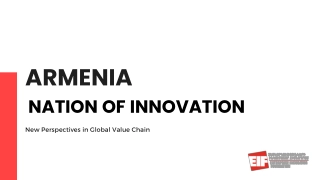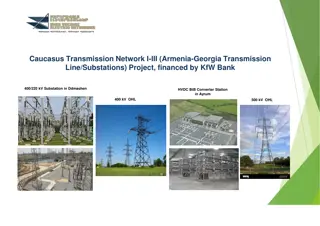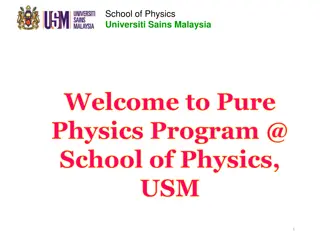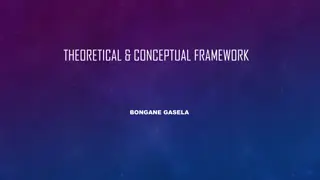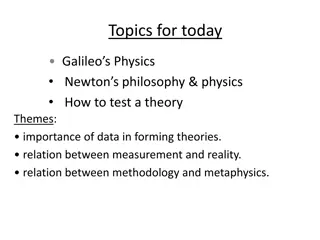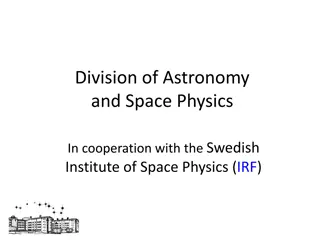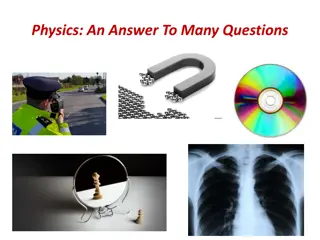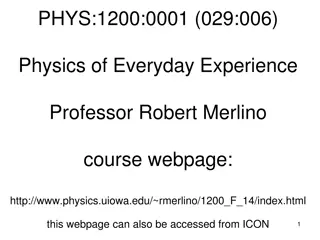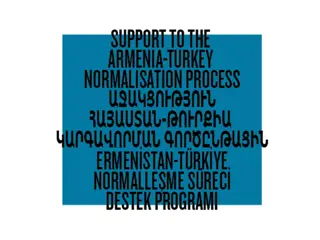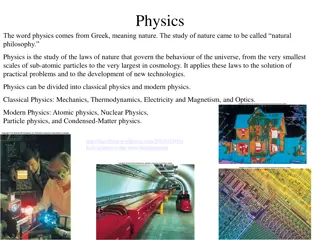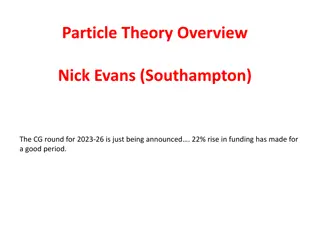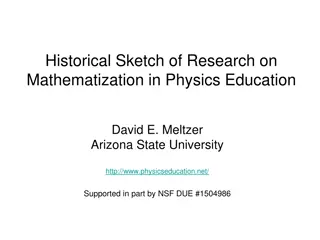Challenges Faced by Theoretical Physics in Armenia
The field of theoretical physics in Armenia has faced challenges such as a decline in the number of active theorists, an imbalance in age distribution, and a loss of internal collaborations leading to integration with Western groups. This has resulted in the need for young talents to pursue opportunities abroad, potentially jeopardizing the future of theoretical physics in the country.
Uploaded on Oct 11, 2024 | 1 Views
Download Presentation

Please find below an Image/Link to download the presentation.
The content on the website is provided AS IS for your information and personal use only. It may not be sold, licensed, or shared on other websites without obtaining consent from the author.If you encounter any issues during the download, it is possible that the publisher has removed the file from their server.
You are allowed to download the files provided on this website for personal or commercial use, subject to the condition that they are used lawfully. All files are the property of their respective owners.
The content on the website is provided AS IS for your information and personal use only. It may not be sold, licensed, or shared on other websites without obtaining consent from the author.
E N D
Presentation Transcript
Armenian group: cooperation experience Armen Nersessian Yerevan State University, Armenia
Theoretical Physics in Armenia Theoretical physics in Armenia shared common problems with another areas in physics in Armenia Theoretical physics was the best developed field in physics in Armenia Theoretical physics in Armenia has been less destroyed than another fields of physics
Population We still have relevant number of active theorists : ~ 60 persons of students : about 200 Bachelors (about 90 masters) in Physics graduate from YSU every year 3-5 PhD thesis on theoretical physics per year *Active theorist = person uses analytical calculations and submitted in arxiv.org at least 3 paper in last 5 years
In 2007-2012 Armenian researchers have got 16 research grants (8 in theor. phys.) from Volkwagenstiftung and 2 grants for organization of workshops (both in theor.phys.) The B-mesons' inclusive rare decays and oscillations, U. Nierste (KIT), H.Asatrian, 2012 Infinite-Dimensional Symmetries, Gauge/String Theories and Dualities, H.Nicolai, S.Theisen, W.Ruhl, R.Manvelyan,R.Mkrtchyan,R.Poghossian (YerPhI) Equilibrium and non-equilibrium behavior of single- and double-stranded biological molecules, 2011 R.Netz (Free U.Berlin), E.Mamasakhlisov (YSU) Astrophysics of compact stars: from dense QCD to gravitational waves, 2010, D.Rischke (Frankfurt), K.Shahabazian (YSU) Optical information processing, driven by adiabatic interactions between light and matter, 2010 T. Halfmann (Tech.U. Darmstadt), G.Grigoryan (Inst. of Physical Research) Algebraic and geometric properties of (conformal) mechanics with extended supersymmetry 2009 O. Lechtenfeld (Hannover), A.N., T.Hakobyan, V.Ohanyan (YSU) Relaxation of spin-polarized carriers in quantum Hall effect systems , 2007 J. Fabian (Regensburg), S.Badalyan (YSU) Quantum thermodynamics: energy and information flow at nanoscale 2007 G.Mahler (Stuttgart U.), D. Janzing (Karlsruhe U.), A. Allahverdyan (YerPhI)
Demography Drastical drop down of the number of active theorists Age Disbalance 51-63 years old ~ 20 41-50 ~ 10 35-40 ~ 5
Consequences Decay of existed internal collaborations. Individual integration in the Western groups. This assume frequent relatively long visits abroad, which does not allow active teaching and thesis advise. These responsibilities are delegated to less advanced theorists. We almost lost relatively young theoretical physics community. Best students prefare to make their PhD abroad or escape in IT
DANGEROUS! Theoretical Physics in Armenia could collapsed within one (realistic) or two (optimistic) decades.
We see the solution in : Inter-disciplinary cooperation Inter-institutional cooperation Regional cooperation
Team In September, 2006 Interdisciplinary studies in theoretical physics. In September, 2007 on its basis, the University Center of Excellence on Algebraic and geometric studies for condensed matter physics (see http://theorphislab-ysu.info), was created which was funded by CRDF-NFSAT grant. After the project has been expired, the group became the part of the Laboratory of Theoretical Physics of of YSU. we established, at an informal frame, the group for the Our Training Network Team includes main partners: Armen Allahverdyan (Yerevan Physics Institute) Evgeny Mamasakhlisov (Lab. of biopolymers, YSU, http://molphys-ysu.info) senior members of that group, and our
Team members Tigran Hakobyan (1965): spin lattice systems, quantum groups, numerical methods, integrable systems A.N. : Integrable systems, quantum mechanics, Hamiltonian methods Vadim Ohanyan (1976): spin lattice systems , integrable systems Gor Sarkissian (1972, since 2011): CFT, Topological field Theories David Karakhanyan (1964, since 2012, YSU & YerPhI): string/QFT high-energy QCD. quantum groups, integrable systems + Evgeny Mamasakhlisov (1964, Chair of Biophysics, YSU), biopolymers Armen Allahverdyan (1973, YerPhI) , statistical physics thermodynamics, information theory, biophysics and everything
Internal Cooperation Regular weekly seminar: 160+ talks This allowed us to find problems of common interest between group members, resulted in collaborative papers with each other and with other Armenian theorists Since 2007 group members published about 60 papers (+37+20) researchers from 3 Armenian and 17 foreign institutions
Internal Cooperation At September 2006: At the current moment No internal collaborations Ohanyan Nersessian Yeghikyan Allahverdyan Hakobyan Sarkissian Mamasakhlisov Karakhanyan
Partner Institutions JINR (Dubna), Tomsk Polytechnic University LOMI (St.-Petersburg) Hannover, Wuppertal, Goettingen, Hamburg, Leipzig U. INFN- Laboratori Nazionali di Frascati CBPF (Rio de Janeiro), Lavras, Sao Andre U. (Brazil) Hebry University (Jerusalem) Czech Technical University Lviv Nat. University Aarus University (Denmark)
External Collaboration. Main Institutions 2007 - 2013 Tomsk Dubna Frascati Leipzig St.Petersburg Hamburg Sarkissian Nersessian Hakobyan Mamasakhlisov Allahverdyan Ohanyan Karakhanyan Fri U, Berlin Goettingen Wuppertal Glasgow XXX Hannover Aarus Hebrew U
Workshops Supersymmetry in Integrable Systems 24-28.08.10 Yerevan, 1-4.08.11 Hannover 27-31.08.12-Yerevan August 2013, Hannover (expected) Armenia-Dubna: Problems of Integrable Systems 24-25 .12.12, Dubna 21-23.12.13, Dubna, expected Physical Concepts of Nucleic-Acid Structure and Behavior (27- 29 May, 2013, Yerevan)
VIP in Armenian Math. Phys. Ruben Manvelyan, higher spin theories Ruben Mkrtchyan universal Lie groups Ruben Poghossian, CFT Aram Saharian, Casimir effect
Additional Financial Support 3 Volkswagen Stiftung Grants 3 Grants from CRDF-NFSAT: INTAS Grant 8 grants from ANSEF (Armenian National fund for Education and Science based in New York) 3 Grants from State Committee of Science
Regional research cooperation ICTP Regional Network Novel approaches to mesoscopic phenomena Armenia- Iran -Morocco- Turkey since 2012 We plan to extend it in 2013 by Ukrainian, Georgian and Moldovan groups
Computer Cluster Characteristics Blader system with Infiniband 8 computer modules, 8 Gb RAM each 16 processors Intel E5405 (2GHz, 4 cores) Total capacity 512 Gflops
Events in 2013 Physical Concepts of Nucleic-Acid Structure and Behavior 27-29 May, 2013, Yerevan International School on Symmetry in Integrable Systems and Nuclear Physics , 3 13 July, Tsakhkadzor The modern physics of compact stars and relativistic gravity , 18-21 September, Yerevan Aspects of black hole physics , 23-24 September, Yerevan
The end Welcome in Armenia Thank you for your attention


